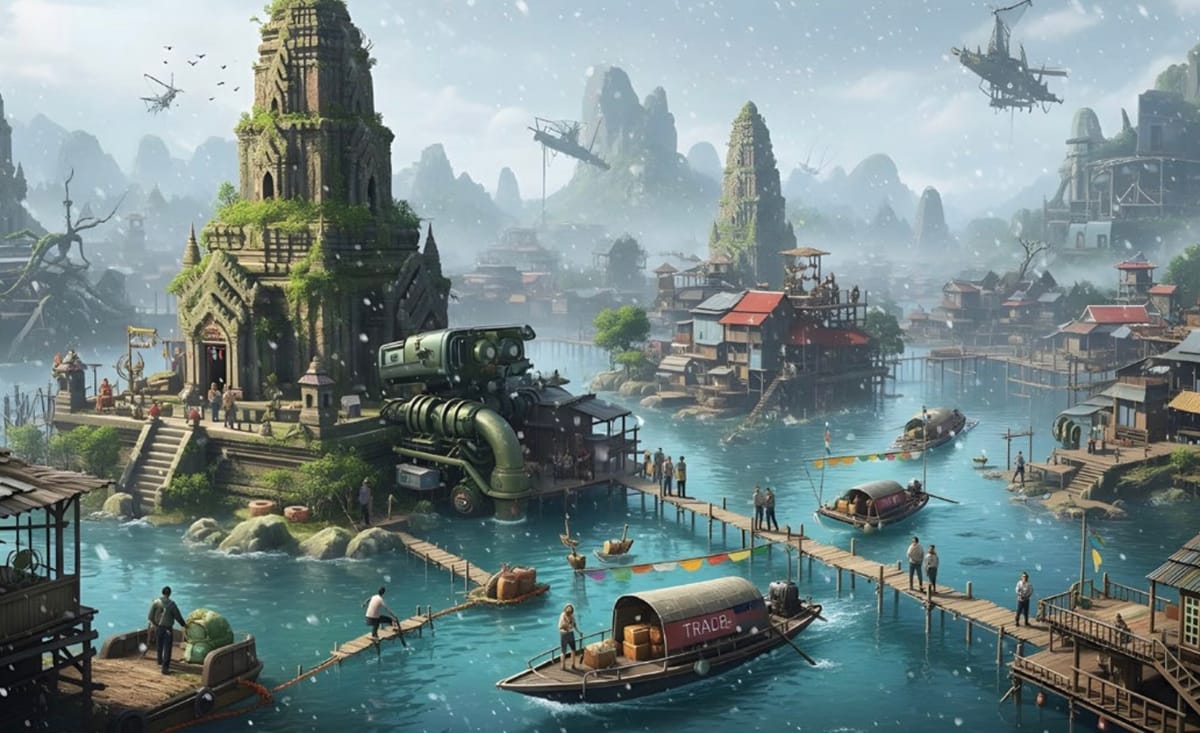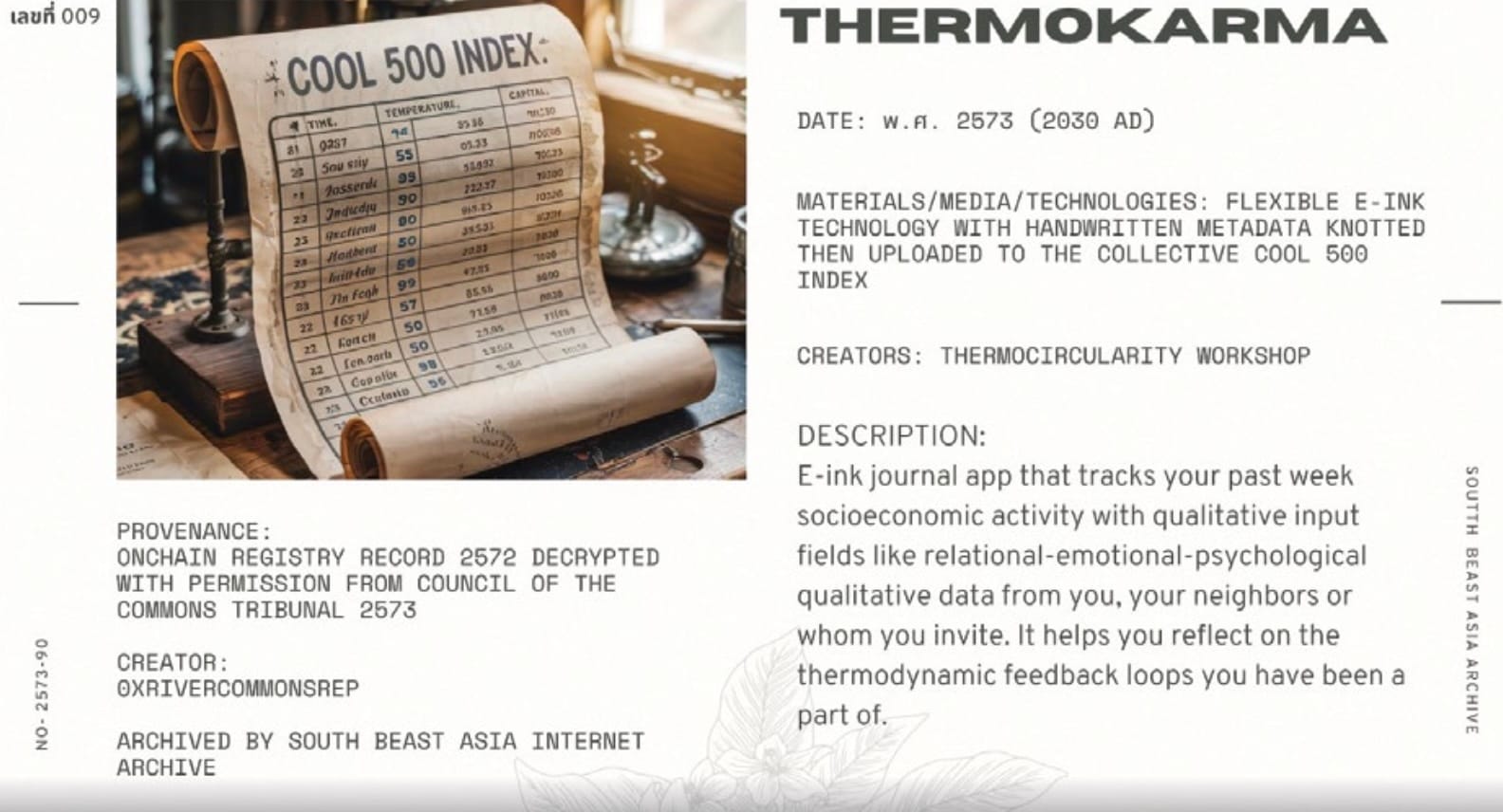Growing sideways: The Seapunk imagination
Sam de Silva (SD), founding producer of Balance, and Sam Chua (SC), founding curator of Seapunk Studios, discuss how imagination, fiction and decentralised design can open up new ways of thinking about power, technology and resistance.

SD: You used to work within the digital rights and tech accountability movement. What made you step away from that space and start Seapunk?
SC: I was quite active in the space from about 2016 to 2020, when I worked closely with Digital Asia Hub and many adjacent actors. That gave me a lot of exposure — I learned about the dynamics of digital platforms, power imbalances and rights-based responses. But, over time, part of me also began to feel that the space as a whole tended to be reactive; defensive, even. And while that's necessary — we need people running interference, building shields, advocating for fair protections — I found myself drawn towards other, more generative directions, inspired in part by some of the experiments I had the chance to be part of with Digital Asia Hub: speculative fiction, summer schools, playshops, dolphin tanks — as opposed to “shark tanks” — and more.
I started wondering: What if, instead of focusing on and reacting to the latest harm, we spent more energy creating our own spaces and protecting them? Not in opposition, but with a kind of indifferent punk sensibility. Not aggressive, but indifferently creative. Like punk music — it doesn’t set out to destroy the mainstream. It just cuts a hole in the fence and finds its own space to play.
That’s the energy I wanted to explore with Seapunk. Not confronting some villainous Big Tech figure, but building worlds that don’t depend on the villain at all. We still care about fairness, justice and power, but we’re more interested in the deeper question: What are rights for? What kind of life do they serve? And can we think beyond the conventional confrontational dialectic to get there?
Can you unpack the name Seapunk for us?
Seapunk works on a few different layers. First, as a genre label — like solarpunk, cyberpunk, steampunk. These are all aesthetic orientations or speculative traditions. Solarpunk is about hopeful ecological futures. Cyberpunk is about high-tech dystopias. Seapunk is our exploration of Southeast Asian experimental solarpunk-inspired futures.
Why “Seapunk”? There’s “SEA”, as in Southeast Asia. But also “sea” as in water — the sea as a medium that shaped so much of this region’s history; that carried trade, culture, migration; that allowed for a kind of decentralised coherence, where distant places could be networked without being unified under a single empire. That’s a big part of the punk spirit too — autonomy without isolation.
And then there’s the idea of “Option C” or a third way (in the original self-declared coining of “Third World”) . Not Superpower A or Superpower B. Not capitalist bloc versus communist bloc. “C” or “SEA” as a third way. Something more non-aligned, fluid, peer-to-peer. That idea of another way that’s cooperative, decentralised and rooted in local agency. That runs through a lot of what we do.
You recently ran the Seapunk Midsummer Studio in Chiang Mai. Can you tell us what that looked like in practice?
The Seapunk Midsummer Studio, or SMS, was a ten-day gathering of a couple dozen people — about half traveling participants and half folks who were already in Chiang Mai. It was designed as an open-ended container. We had reading seminars, fiction jams, design sessions and an academic paper presentation. We also spent a lot of time sitting around, talking, sketching, thinking, researching, imagining.
One activity was a sci-fi workshop called ‘Good Ghosting’. We explored the idea of artificial ghosts — AIs programmed to inhabit objects or places. So instead of AI as an all-knowing chatbot, we imagined small, localised presences: artificial ghosts. A ghost in a tree. A ghost in a temple gate. A ghost in a marketplace stall. These ghosts might monitor soil health, protect a forest, tell stories or mediate conflicts. They don’t scale. They haunt. And they nudge us to ask: What does it mean to embed intelligence into the world, not just on top of it?
We weren’t trying to invent tech products. We were trying to loosen our thinking — to imagine technology as presence, spirit or kin. That kind of sideways approach led us to insights that straight-line policy work might otherwise have missed.

You also presented a paper on “imaginary decolonisation”. What was that about?
We presented at an academic conference on decolonising Southeast Asian studies. Our paper, co-authored by Jules Yim and myself, was titled ‘Imaginary Decolonisation’. The idea is that real decolonisation doesn’t stop at territory or institutions. It has to include, or even begin with, the imagination — how we see ourselves, what we think is possible, what futures we believe we’re allowed to build.
If the powerful people in a postcolonial country still extract resources and exploit the land using colonial logics, that’s not real decolonisation. Even if they look like us. Even if they speak our language.
We proposed four shifts: from dominion over nature to living with it, from centralised sovereignty to distributed sovereignty powered by shared commons, from either/or science and spirituality to a syncretisation of both, and from urbanisation-centric modernisation to cosmo-local reimaginings of rural versus urban ways of how we live upon the land. These aren’t policies per se, although they underlie many potential policies and systems. They’re orientations — prompts for imagining otherwise.
In the digital rights struggle, there’s a lot of energy invested in trying to shift the needle on tech power, but it feels like we’re always behind. What’s your take?
That’s fair, I certainly feel that. And I don’t have a five-point plan to fix it. But one thread we explored recently was thinking about AI through the lens of theology. The dominant public conception of AI feels very monotheistic. There’s one AI behind an interface, whose behaviour we struggle desperately to align. You prompt it with some combination of words, almost like a prayer. It answers. It’s mysterious and powerful, and generally speaks as though it’s all-knowing.
But in one of our worldbuilding exercises earlier this year, what emerged was a universe of AIs that could best be described as wildly polytheistic. Where AIs are embedded everywhere — in trees, in cats, in altars. Small gods. Local intelligences. A distributed spiritual ecology.
That kind of model — a polytheistic model — enacts (or emerges) alignment through ecological checks and balances. Not through legislation or regulation, but through ecology. No single AI has all the power, just as in polytheistic pantheons, where no single god has all the power. They contradict each other. They protect different things. And the system becomes more resilient. Alignment, we discovered through this exercise, has different pathways. What if distributing agency could be just as, or perhaps even more, effective towards achieving dynamic societal balance as fighting for rights?
That idea has stayed with me. What if balance in tech didn’t always come from one big governance structure, but from cultivating many small, overlapping agents? That’s not something I learned from a digital rights report. It came from imagining sideways.
So is Seapunk trying to build these systems? Or just imagine them?
Seapunk Studios is mostly upstream, at the level of culture and imaginaries. We do research and imagination. But much of what we produce might also filter and manifest downstream. Some builders or policymakers or social entrepreneurs might encounter these provocations, these patterns, and apply them to their work — whether in cybersecurity, design, education, policy or otherwise. So Seapunk is about expanding the imagination layer, which in turn expands all downstream layers from there, which we hope expands the range of futures we might build and inhabit.
We’re not just imagining by ourselves, but also creating and sharing scaffolding for others. For example, we created a tool called the Protocol Design Fiction Canvas for a workshop earlier this year. It’s a way to build imagined worlds through designing their component artifacts, systems and protocols. This is what we more or less used in the building of South Beast Asia earlier this year. It’s now released for groups and facilitators to use under a Creative Commons license. Anyone can use it. Some already have.
I’m personally interested in taking certain concepts further — maybe into apps or prototypes. But I don’t think everything needs to scale, and certainly not led by me or with myself as the bottleneck. Sometimes fertilising the field is enough.
How do you see this connecting with civil society organisations more broadly?
I don’t think we’re trying to convince or convert anyone, civil society organisations, corporations, entrepreneurs and so forth. Punk doesn’t try to fix others. It makes the things it’s interested in and leaves the door open.
We host and run playshops. We publish tools. We jam with people who are curious. Some of those people are policymakers. Others are artists or engineers. And when they remix what we’ve done in their own context, that’s great.
One of the benefits of fiction and speculation is that it lets you break out of the “solution space”. You don’t have to fix the world. You just ask what other worlds are possible — and maybe fun.
Are you hopeful this kind of orientation can actually rebalance power?
Hope’s a funny word. But I’m energised.
At the end of the Midsummer Studio, we held a salon on power. Some people felt overwhelmed — that Big Tech is too entrenched and people are powerless. But someone said, “Power is just one lens. There’s always agency, if you shift the frame.”
That stuck with me. Even a seed growing out of the side of a cliff isn’t thinking about power. It just notices water in the crack, finds light, and grows.
That’s how I think about Seapunk. Not trying to solve a huge systemic problem, but learning how to grow sideways. To sense. To relate differently to complexity. And what’s been encouraging is that other people — even some system designers — have felt energised by that too.
Not everyone building big systems wants to dominate. Many are looking for ways to design without bottlenecks and move past extractive or parasitical dynamics. So if our weird little imaginings can offer tools, moods or metaphors that help — that’s already a win.
Sam de Silva is the founder and producer of Balance and lead of CommonEdge Asia. He works at the overlaps of technology, culture, human rights and info/communications.
Sam Chua is a cultural entrepreneur and the founding curator at Seapunk Studios. His work explores the intersections of research, imagination, and the catalytic hosted experience.
Join one of the following groups and we'll keep you in the loop, including sending you a copy of the digital version of the first issue of Balance.
Join Signal Group | Join Whatsapp Group | Join Telegram Group




